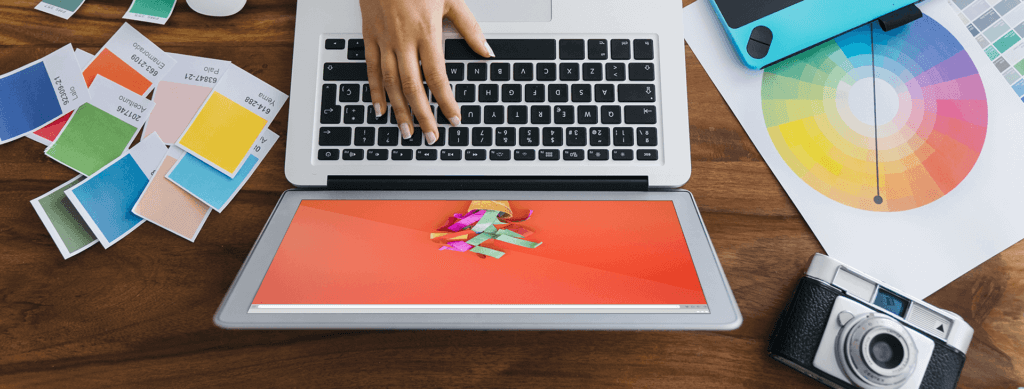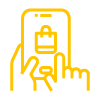O que uma empresa ganha ao investir em design?

A pergunta “O que uma empresa ganha ao investir em design?” vem ganhando cada vez mais relevância no mundo moderno. O design do dia a dia não se limita à criação de telas bonitas. Na verdade, o design na prática busca solucionar problemas reais e cotidianos de forma humana.
Sim, o mundo mudou e vai continuar mudando bem rápido. A tecnologia evolui diariamente e a relação das empresas com os consumidores mudou expressivamente nos últimos anos. O cliente não está em busca apenas de um produto que atenda às suas necessidades ou de um serviço que solucione seu problema: ele precisa de uma experiência de qualidade, do começo ao fim, para que ele volte a usar o seu produto ou serviço. E é exatamente na experiência de qualidade, que o design pode ajudar a sua empresa.

(fonte: DMI / Design Management Institute)
O que é UX/UI Design?
O conceito de User Experience (UX) consiste em colocar o usuário no centro da construção de qualquer produto ou serviço. É necessário entender suas dores, necessidades e contextos de uso para que aquele produto/serviço faça entregas de valor, gere boas experiências aos clientes e que atenda uma necessidade do negócio. A empresa precisa atuar na construção e manutenção do produto/serviço, para que a experiência seja cada vez melhor.
O que é User Interface (UI)?
Muitas pessoas entendem que uma UI se limita a uma tela de um aplicativo ou site, mas o conceito de UI é muito mais amplo e complexo. Por exemplo:
“Alexa, ligue o ar condicionado”.
Se comunicar com a sua Alexa, é um lindo exemplo de interface de usuário! Apesar de você utilizar um comando de voz, não deixa de ser a interface que você utiliza para interagir com um produto ou serviço, assim como seu mouse e teclado. São formas diferentes de interagir com o seu computador.
Quais as diferenças entre UX e UI?
Apesar de serem conceitos complementares e estarem conectados, UX e UI exercem papéis diferentes na construção da experiência do consumidor.
UX Design ou Experiência do Usuário: é a nomenclatura dada para classificar o processo de interação do cliente com um produto ou serviço, a partir dos recursos disponíveis e necessidades do usuário.
Entregar uma experiência de qualidade ao cliente é fundamental para o sucesso de qualquer marca. O UX está presente em todas as etapas da construção do produto, não apenas na fase final.
No caso do UI ou Interface do Usuário, trata-se da área responsável por criar interfaces mais amigáveis, intuitivas e com o menor “atrito” possível para a realização da tarefa. Consequentemente, impacta na experiência do cliente, por isso, UX e UI estão intimamente interligados.
Um dos grandes desafios da área de UI é descomplicar as formas de uso. Isso abrange especialmente o universo de produtos. Você já reparou que objetos simples do cotidiano, como o controle remoto, também mudaram nos últimos tempos? Estão mais amigáveis e simples. Isso é UI!
Mas o universo da Interface do Usuário não é apenas isso, aliás, está mais presente no seu cotidiano do que você possa imaginar.
Conheça as vantagens de investir em UX/UI Design na sua empresa
Investir em experiência do usuário e no aprimoramento dos pontos de melhoria é fundamental para ter um negócio mais estratégico e alinhado com os anseios do seu público, além de ser uma excelente oportunidade de corrigir e evitar possíveis falhas.
Nunca foi tão importante, como agora, analisar o comportamento do usuário, suas predileções e a maneira como ele atua, por isso, é importante que as empresas estejam antenadas a esses sinais para interpretar e traduzir as necessidades de maneira assertiva.
Design na prática: Entenda como UX/UI traz mais sustentabilidade para sua empresa
Você já sabe que é importante ter um olhar atento à experiência do usuário, mas UX/UI não se resume apenas a isso, vai muito além.
Toda empresa, para manter-se competitiva e ativa, precisa garantir que seu produto ou serviço seja assertivo. Tudo isso começa na jornada de construção e o UX/UI te ajuda a tomar decisões precisas, baseadas em dados, experimentos e protótipos, trazendo mais solidez e segurança, em todas as etapas deste processo de desenvolvimento.
O mercado de produtos digitais muda de maneira veloz e a continuidade do seu produto pode estar comprometida, caso você não esteja atento às métricas, elas são como uma bússola que irá ajudar a guiar os próximos passos.
Para te ajudar a entender mais sobre o assunto, listamos as principais métricas focadas no desenvolvimento de produtos digitais e o enfoque de cada uma delas, confira:
Custo de Aquisição do Cliente (CAC)
Essa métrica define o custo médio necessário para conquistar um novo cliente. O CAC é vital para analisar a viabilidade de um modelo de negócios e para avaliar investimentos em marketing de produtos.
Exemplo: se os seus investimentos diretos em aquisição de clientes somam R$ 20 mil no mês, e com isso você conseguiu 20 clientes, o seu CAC será de R$ 1.000,00 por cliente.
Importante mencionar que este cálculo é feito sempre considerando também investimentos e novos clientes no mesmo período.
Customer Lifetime Value (LTV)
O LTV ou Valor de Tempo de Vida do Cliente (VTVC), é o valor que o seu usuário entrega ao longo de todo o período em que é assinante ou usuário de um produto. Essa métrica é fundamental para mensurar o valor financeiro de cada cliente.
As áreas de Customer Success (ou Sucesso do Cliente) e suporte ao cliente influenciam diretamente essa métrica. Quanto mais satisfeito o cliente estiver, mais chances ele tem de continuar sendo um cliente leal.
Churn Rate (CR)
A Taxa de Cancelamento ou Abandono, mostra o número de pessoas que
deixaram de ser usuários frequentes ou assinantes de um produto digital. Entender o impacto dessa métrica na saúde financeira da sua empresa fará toda a diferença para mantê-la lucrativa e forte no mercado por muito tempo.
O primeiro passo é definir um período de tempo para o cálculo, pode ser anual, semestral ou mensal. Desta forma, você terá o churn com base em determinado tempo definido.
Churn = (clientes que cancelaram)/(clientes do início do mês) x 100
Net Promoter Score (NPS)
O NPS é uma métrica bem tradicional com o propósito de medir o grau de satisfação dos usuários com o produto, funcionalidade ou serviço digital.
Existem uma série de outras métricas, como MAU (monthly active users ou Usuários Ativos no Mês) e DAU (daily active users ou Usuários Ativos por Dia), ROI, Bounce Rate, avaliações em loja de aplicativos e muitos outros. Cada produto ou serviço traz uma necessidade específica de acompanhamento.

Agora você já sabe como os dados podem orientar suas decisões de negócio de maneira estratégica, evitando erros e potencializando os resultados positivos da sua empresa.
Não fique apenas na teoria, é importante colocar esses conhecimentos em prática para que você colha todos os benefícios de investir em Design em todo processo de desenvolvimento de produtos e serviços digitais.
Leia também: Como a Quality Assurance pode ajudar no desenvolvimento de produtos digitais?
O design do dia a dia: Confira os principais benefícios que o UX/UI pode trazer ao seu negócio

Aumento na conversão
Quando todas as etapas da jornada de compra são bem desenvolvidas e testadas, isso potencializa as chances de compra de quem ainda não conhece sua marca e aumenta a fidelização de clientes que já tiveram interações positivas.

Melhor experiência de compra
Esse é um dos objetivos de qualquer marca, melhorar a experiência do usuário em toda sua jornada de compra, por isso, é importante investir na criação de um ambiente digital que potencialize suas chances de conversão e fidelização.

Maior credibilidade
Não existe propaganda melhor do que a satisfação do cliente, por isso, é importante oferecer uma experiência que transmite qualidade e confiança. Quando o usuário está satisfeito, a conexão com a marca torna-se ainda mais forte.

Fortalecimento da marca
Quando uma empresa demonstra preocupação com a experiência de seus clientes, ela acaba gerando uma grande aproximação com o público, o que se torna um diferencial.
No contexto digital, oferecer uma boa experiência ao cliente gera comentários que podem afetar sua reputação de maneira negativa ou positiva, sobretudo, porque nos últimos anos, diversas plataformas têm centrado sua credibilidade através das recomendações. Você já deve ter notado que é possível avaliar a comida de um restaurante, o serviço de transporte por aplicativo e tantos outros.
Para garantir que o seu cliente tenha uma experiência de qualidade, é importante considerar o trabalho de UX e UI Design, ambos são vitais para o sucesso da sua marca.
Como aplicar práticas de design na sua empresa?
Como você deve ter notado, é essencial investir numa experiência humanizada, personalizada, fácil e simples. Dessa forma, além de criar uma conexão em potencial você garante a continuidade da sua marca.
Não há como criar uma jornada de sucesso sem colocar o usuário no centro das decisões. A levva tem um time de especialistas com ampla expertise em projetos de UX/UI. Converse conosco e saiba como podemos ajudar sua empresa!


